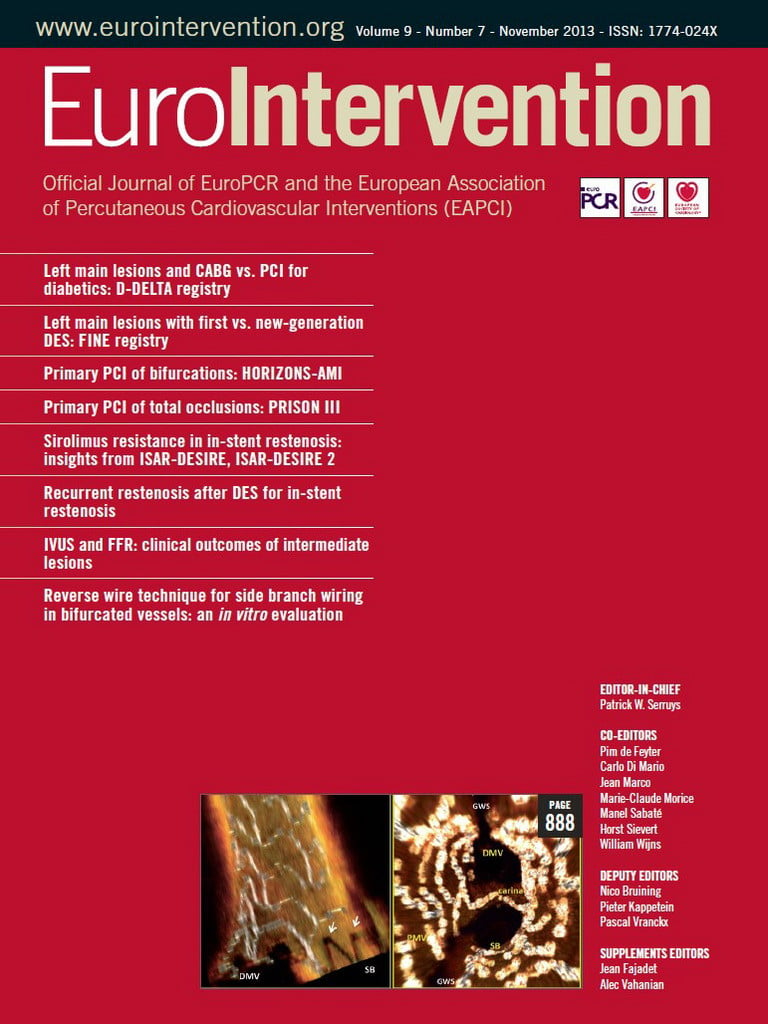From what used to be frequently called the “Far East” to what is known as the “Near East”, this month’s edition of EuroIntervention is poised between two interesting meetings which will take place shortly after we publish. The first is the CBS meeting in Nanjing, China, focusing on the challenging treatment of left main disease and bifurcation lesions. Immediately after this “far eastern” event, ICI will take place in the “Near East” in Tel Aviv, Israel – the yearly meeting dedicated to innovations for interventional medicine. Spanning the continent of Asia –and a harbinger of our participation in January at Asia PCR/SingLive– this month’s issue of the journal will touch on many of the topics of interest to be seen at all these meetings.
The field of bifurcation lesions is very well represented in November’s EuroIntervention, beginning with the HORIZONS AMI study in the setting of acute myocardial infarction. This paper discusses the largest comparison of patients with bifurcation lesions vs. patients without bifurcation lesions in the setting of MI. The authors conclude that the presence of a bifurcation lesion with the intention of using a provisional approach has no prognostic impact on the outcome of patients treated in the setting of an acute myocardial infarction. From a more “technical/clinical” point of view, our colleagues from Japan discuss a new technique for side branch wiring in bifurcated vessels, with the goal of addressing the question of difficult side branch access using a novel wiring technique. We also present, as a general basic reference in bifurcations, another instalment of our well-received EuroIntervention Tools and Techniques series, where colleagues from London present insights into optimising stenting strategy in bifurcation lesions. Also, in terms of innovation, the editorial by Carlo Di Mario et al comments on the innovation of bifurcation treatment using the Absorb bioresorbable vascular scaffold.
Concerning left main lesions, we are presenting two articles in the journal this month: the first presents the results from the Milan group on the comparison of first and second-generation DES used in left main lesions; the second, a more international paper, presents the results of the D-DELTA registry (CABG vs. PCI for diabetic patients with unprotected left main), which, in a large population, evaluated the “short-term and long-term results of percutaneous and surgical revascularisation in diabetic patients with ULMCA disease.”
Despite the best efforts of researchers, restenosis remains a still worrisome issue for clinicians. Fernando Alfonso’s editorial commentary on the Kubo paper (concerning the treatment of recurrent restenosis lesions) proposes further determinations on the value of drug-coated balloons in patients with recurrent DES-ISR, especially in the presence of multiple metal layers. Adnan Kastrati’s group uses data from the ISAR-DESIRE and ISAR-DESIRE 2 trials to present an interesting analysis on a topic which has very little data for the moment –but is of major interest to interventionalists– what is the role of drug hyporesponsiveness as the mechanism of initial treatment failure for DES-ISR?
So, from innovation to research, from cutting-edge clinical techniques to the very basics of practice and from the Pacific to the Mediterranean and back again, EuroIntervention spotlights the concerns of the interventionalist, accompanying you both in your practice and on your journeys abroad. Next month we will be focusing on Asia again, never forgetting that we remain a European journal with –since the very beginning– a strong Asian and international participation both in our readership and authors and in our editorial board.

